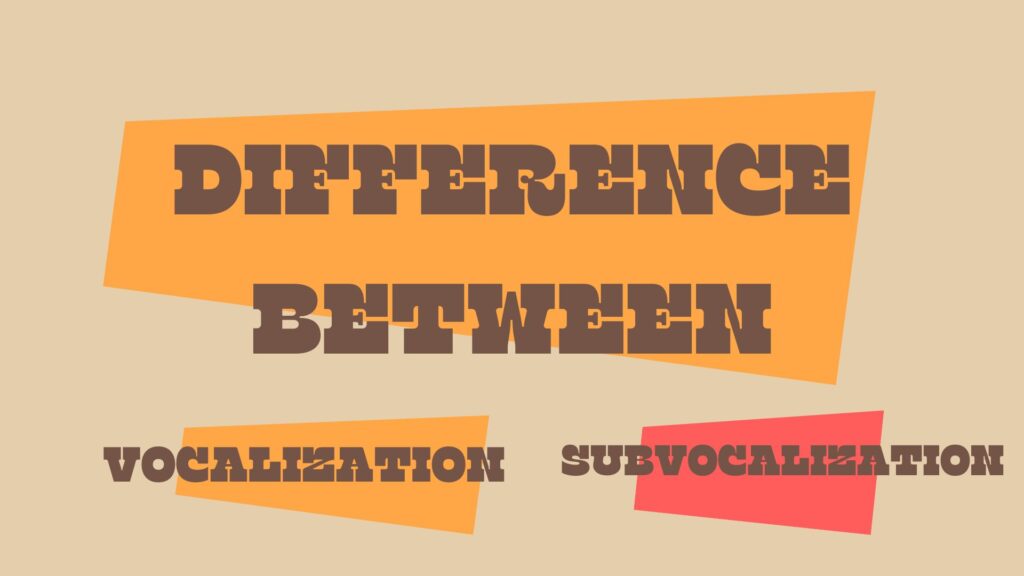“Vocalization vs subvocalization” – Is this how you feel inside your head when you read? Like everything you read is echoing once again? Or maybe, your lips echo back what your brain has already read through your eyes? These are the habits of vocalizing and subvocalizing, and we have tried to help you understand the differences between vocalization and subvocalization in this article.
People follow various reading practices. Do I read things out loud? No, I don’t. Do I hear voices inside my head while I read? Yes, I do. So, yes, these may or may only happen to some.
Vocalization is basically when you read things out loud. Subvocalization is Mr. Voice inside your brain when trying to read something. There is a thin line of difference between these two. Other than this major one.
Here in this article, we briefly discussed two debated topics on reading methods – vocalization and Subvocalization. We have tried to explain and differentiate them to help you understand your reading style.
Difference between Vocalization and Subvocalization in Detail
The Table
| Sr.No | Vocalization | Subvocalization |
| 1 | This is reading the words out loud when you are reading something | This is reading things silently inside your head |
| 2 | Vocalization is mostly intended type of reading | Subvocalization is unintended at most times |
| 3 | This greatly reduces your reading speed | This reduces your reading speed comparatively |
| 4 | Vocalization begins when we first learn to read and can be reduced eventually | Subvocalization evolves alongside your reading practice. |
| 5 | This must be reduced if you would want to increase your reading speed | This needs to be reduced if you would like to become a speed reader |
| 6 | We tend to do this as a reading habit trying to focus more on the subject that e read | This is practised voluntarily by our brain to keep us concentrated on the things that we read |
| 7 | This can be reduced by keeping in mind that we need to look deep into the meaning the word is trying to convey rather than the sound | This can be reduced by improving your reading speed |
Scroll to read more about vocalization and subvocalization in detail.
Vocalization

1. What Is Vocalization?
Vocalization is sounding the words out loud when you read something. We might have seen children reading things like this in their textbooks when asked to read out something. Sometimes, it is said that reading things out loud helps you keep them in your memory more robust.
There is no scientific research proving this. But this practice sometimes becomes a habit, which we call vocalization.
2. Is Vocalization a Bad Reading Habit?
The eyes move faster than the mouth. So when we read aloud each word aloud, our reading speed decreases eminently. Vocalization helps us focus on what we read but is not usually categorized as a good reading habit.
Reducing how much you vocalize can help increase the number of words you read. So it is recommended to find a convenient way to minimize vocalizing. Various methods help to eliminate vocalizing and aid in speed reading.
3. How to Eliminate Vocalization?
The main reason behind vocalization is we perceive words as sounds rather than the meaning or emotions they are trying to convey. We see words, and we feel the need to pronounce them. The fact that how they sound comes to our mind first rather than what they are trying to convey.
This results in the loss of reception of their meaning. This is a significant drawback of vocalization. Understanding this will help better in reducing this.
4. Don’t Perceive Words As Sounds.
Take in words as symbols, like something with a meaning. Not seeing them as something that needs to be given some sound.
5. Increase Your Word Intake
Try reading more words than you usually read. This will prevent you from vocalizing what you read. On the other hand, this also helps you to speed read.
How to read more books How Many Books Can One Possibly Read in Their Lifetime?
6. Focus More
Try to concentrate more on what you read. Try to think harder about the ideas the book is trying to tell. Focus on the meaning.
7. Shut Your Ears off
Sound and speech are intertwined. If you try something like imagining your ears are shut off, it may help reduce the vocalization. If you heard what you read, you would want to read it aloud.
Subvocalization

1. What Is Subvocalization?
Subvocalization is reading things inside your head. It is not universal, meaning It doesn’t happen to everyone. Some people read without subvocalizing, and a majority read by subvocalizing.
Subvocalization can also be defined as one of the reading methods. You may even experience it while reading this. A voice in your head might be pronouncing the words loud when you don’t want to read things aloud.
For some, there might even be tongue movement without moving the lips. For some, the lips move too, but without making any sound.
2. Is Subvocalization True?
Some people deny the phenomenon of Subvocalization. As already said, this only happens to some. So, for those who this doesn’t happen, they say this phenomenon doesn’t even exist. Research is still going on to discover whether this is true or not and also to discover methods to stop subvocalizing.
3. Does Subvocalizing Affect Your Reading?
Yes, it does. It is still a debate whether it is good or bad. But does it affect your reading speed? Yes, it does. When you read by subvocalizing, your reading speed reduces to your average speech rate.
Also, a speed reader can read about 450 words per minute, while a regular reader can read only 150 – 200 words per minute due to Subvocalization.
4. Is Subvocalization Bad?
It is neither completely good nor completely bad. When Subvocalization reduces your average reading speed comparatively, it increases the number of words you can comprehend. When people speed read, they don’t get the entire content or at least the most details into their heads.
But Subvocalization allows you the pace at which you can comprehend each word, note the details, realize the beauty of the language, and much more.
5. Types of Subvocalization
There are, in general, two types of sub-vocalizers – high and low. These are self-explanatory. Low sub-vocalizers do not use their throat, lips, or any sound organs during reading. There is just an inside voice in their head.
On the other hand, high sub-vocalizers read things loud with their mouth. It may not be as intended reading as normal vocalization. It is an extension of the voice inside their head.
6. Does Subvocalization Affect Your Speech?
There is evidence showing that Subvocalization affects your speech. Sometimes, you may subvocalize a word or sentence when looking at it elsewhere other than when you are reading a book or magazine or anything of that sort.
You might have intended to read that word in mind, but unknowingly you might have highly subvocalized it. There is no need for any embarrassment here. Still, this is considered to be a harmful impact of sub-vocalizing.
7. Do We Subvocalize Everything We See?
Though Subvocalization is often unintended, and we realize it only after we start subvocalizing, we only do it sometimes. Subvocalizing is a way in which our brain tends to keep the focus on the words we are trying to read.
Tap to read More How to Stop Subvocalization
When we read things unintentionally, like seeing a label, an advertisement sign, or name boards on roads or somewhere else, we usually don’t subvocalize. So, it only happens sometimes all the time.
Conclusions | Difference between Vocalization and Subvocalization
Some difficulties and distractions keep us from improving our reading habits and becoming proficient and speedy readers. Vocalization and Subvocalization are just two of them. There are various methodologies to overcome these.
And sometimes, it is okay to eliminate these. You need not try to reduce vocalizing or to subvocalize just because it isn’t universal. If you feel confident and comfortable with your reading style, then it isn’t necessary to change it.
If you want to become a speed reader or anything of that sort, you can try changing things at that time.




